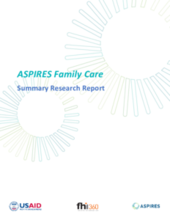Background
With support from USAID’s Vulnerable Children Fund (formerly Displaced Children and Orphans Fund - DCOF), the Accelerating Strategies for Practical Innovation and Research in Economic Strengthening (ASPIRES) Family Care Project focused on how economic strengthening (ES) interventions can help prevent unnecessary separation of children from families as well as support the reintegration into family care of children who were already separated. In particular, the project sought to assess how to match specific kinds of economic strengthening activities to the capacities, limitations, and context of particular households, with the aim of supporting the development of technical guidance to inform future programming. Through Family Care, ASPIRES supported two learning projects in Uganda: the Family Resilience (FARE) project, implemented by AVSI Foundation, and Economic Strengthening to Keep and Reintegrate Children in Family Care (ESFAM) project, implemented by ChildFund. Both projects were intended to reach economically and socially vulnerable families at risk of separation (prevention families) and those whose previously separated children were returning to family care (reintegrating families). Implemented between late 2015 and early 2018, the Family Care projects were based on the theory that a combination of case management, family social support and household economic and livelihood strengthening would stabilize highly vulnerable households, facilitating the return of separated children to family care or preventing children’s separation from their families. FARE was implemented in more urban areas, where the cost of living and incomes are, on average, higher than in the more rural areas where ESFAM was implemented.
ES activities across FARE and ESFAM included cash transfers (CT); cash transfers plus participation in a savings group (CT + village savings and loan association, VSLA); savings groups (VSLA) without cash transfers; matched savings accounts (MSA); community training in income generating activity skills (Comm Skills); only financial literacy or business skills training, youth apprenticeship or other non-primary ES activity (Other ES); or no ES for those who could not access or chose not to participate in any economic strengthening activities (No ES). FARE cash transfers and all ESFAM ES activities were assigned based on the assessed level of household poverty. In addition to these ES activities, all households received family support activities including, at a minimum, case management and counselling by project social workers, and for many, training on parenting skills for caregivers. Most households received Family Care interventions for a period of approximately 12 – 18 months, beginning in September 2016 and concluding in January-February 2018.
Methods
Because ES activities should be matched to a household’s situation and because of uncertainty about when and where households in the reintegration sample would be reunified, random assignment of ES activities to households was not advisable or feasible within the Family Care research design. The Family Care team therefore designed a mixed methods evaluation to be implemented alongside programming that included longitudinal quantitative data collection with all participating FARE and ESFAM households (N=1305) at three time points to assess a range of indicators related to household economic and family well-being. Descriptive statistics were generated at baseline and endline for more than 20 outcome variables selected from across the domains of economic well-being, social/family well-being, and child protection. Changes in the average or distribution of responses were calculated and tests of statistical significance were performed, as appropriate.
The data are disaggregated according to separation status (at-risk or reintegrating) and the primary economic strengthening activity the household participated in. Additionally, the research design included in-depth, longitudinal qualitative research to help understand how (well), from participants’ perspectives, the FARE and ESFAM interventions aligned with perceived drivers of separation and families’ experienced child-level effects of programming.

